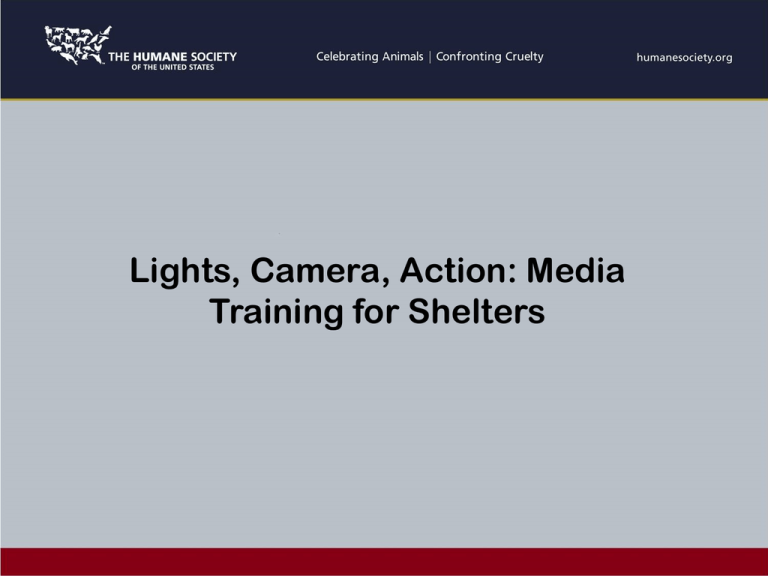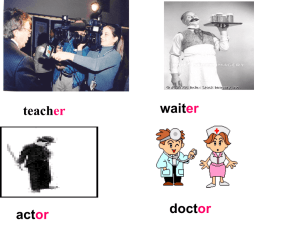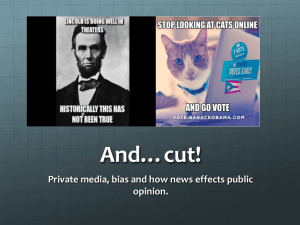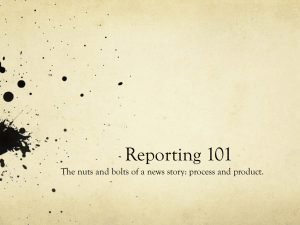Media Training for Shelters
advertisement

Lights, Camera, Action: Media Training for Shelters Communication Matters Allows you to help define how the community sees you Media coverage forms a first impression for new supporters, adopters, donors Positive media exposure increases support base, donations Every story is an opportunity to send a positive message. Are Reporters the Enemy? Almost everyone has had a bad experience with the press, being misquoted, taken out of context, “burned.” While this can make it hard to trust a reporter again, they are key to conveying our messages. So how do you manage reporters? Learn what they want and how to use it to your advantage. The Reporter’s Goal The bottom line is most reporters have one goal -- to get a good, interesting story -- and they need your help. Spell it out ---what is the news and why should they (and by extension the public) care? Don’t want until they come to you with a story – your shelter has newsworthy stories every day, be proactive about alerting local reports to them Be Proactive • Reporters can be an ally if you don’t wait until a crisis happens to reach out to them; enlist them ass a way to effect positive change in your community • Offer to take your local reporter to lunch! Talk with them about what you do, show them your facility, be honest with them about challenges • Send them prepared message ideas (e.g. hot car info in summer, don’t adopt bunnies at Easter, etc.) • Reporters that know you and your organization are less likely to believe hype they hear from opponents. Prepare for Handling the Inevitable Media Call • Designate one individual to be your media contact, and be sure that they receive periodic media training refreshers • Ensure that all staff and volunteers know that only the designated PR individual is authorized to speak on behalf of the organization Getting “the Call” Whenever a call comes from a reporter, try and find out: What is the subject of their story? Do they have an angle? How can you help? What do they need from you? How much of your time do they need? What is their deadline? Important -- you don’t have to respond right away! It’s perfectly acceptable to postpone slightly so you can gather your thoughts. The Game Plan Start with the end: No matter what the reporter’s agenda is, ask yourself what you want to see in the story. Develop 2-3 messages that you want to get across no matter what the questions are. Be specific – create a clear call-to-action the public can follow. Focus on positives – what you DO, rather than what you don’t do While you can’t script an interview, you control what you say! Do your homework – if you don’t already know the reporter, check out their past stories for their perspective, etc. Always take an opportunity to offer final comment that reinforces your messages. Message Examples Say a reporter calls asking about a rash of “stolen dogs”. Possible messages include: Members of the community can help avoid this by making sure their pet has a proper identification, both visible to the eye and implanted, and ensuring that their pet is not left in an unsecured location unattended. Stat: Only XX% of pets in our community have licenses and wear ID tags. Through our free microchip clinics we are working to thwart theft and help more pets return safely home if they become lost. Stat: We provided XX animals with free microchips last year. Take the Time to Practice More practice = better interviews Have someone ‘play reporter’ for you, particularly someone who is not well educated on the subject (represents the general public) Brainstorm the tough questions you expect to be asked. Practice your key messages and bridging to them. Ask your fake interviewer to include “curve ball” questions. Don’t memorize words but ideas. Take It from the Top Reporters are people too, doing a job. Before the interview begins feel free to engage in polite small talk (making sure to avoid getting so comfortable with the reporter that you say things that are off-color, sarcastic or controversial). Take a few minutes at the start of the interview to confirm what the reporter wants to speak about Ask them what they think so far about the story. What have they learned from prior interviews? Framing Your Responses Remember, YOU control your responses. You have the ability to steer reporters’ questions back towards your prepared messages. Example: Reporter: Aren’t you putting animals at risk by spaying/neutering them? Response: Spaying and neutering has been one of the most important factors in reducing the number of animals that end up in shelters. You can do your part to help us by not inly having your pets altered but keeping them properly identified, participating in our foster program, and adopting your next pet. Wash, Rinse and Repeat Repeat and rephrase your messages often throughout the interview. The more you repeat your 2-3 key messages, the more likely they will be used. Bridging language can be helpful in repeating yourself gracefully: “To be clear ....” “Again, for emphasis, ....” Make the same point in different ways. Use multiple examples. False Premises/Paraphrasing If a reporter’s question is based on a false assumption, correct the assumption rather than answering the question; don’t let a completely false presumption stand uncorrected. Reporter: Doesn’t the fact that most kittens die during spay/neuter surgery give you pause about your spay/neuter program? Response: Let me clarify, the facts are that our clinic has had no kitten deaths in the last 5 years. Paraphrasing can go both ways - if a reporter paraphrases you inaccurately, don’t let it slide; take time to politely correct the reporter. So you’re saying you are saying kittens died during surgery 6 years ago? Response: Actually, I’m saying we have never lost a kitten in the last 5 years our clinic has operated… Rapid-Fire Questioning If a reporter asks you a long list of questions at once, you don’t have to answer them all. Pick the one you like best -- the one that gives you the best platform for your messages – and answer that. Then make them feed you the rest. “I think you had another question?” Hypothetical Questions Avoid answering hypothetical questions -- don’t get drawn in Reporter: “So if you had to choose between saving one sick puppy and three healthy adults, which would you choose?” Response: “Of course, our ideal would be to save all of them. The more money people give, the more we can save.” Absent Party Ploy Avoid buying into questions based on rumors/hearsay. You have no idea who the reporter has or hasn’t spoken to -play it safe, don’t get dragged in. Reporter: “I’ve talked to a lot of people who say your shelter doesn’t adopt to citizens who live on Millionaire Row. What do you say to that?” Response: “I can’t speak for anyone else, but I can tell you that we have many supporters and adopters from Millionaire Row, and I’d be happy to have you speak with them. ” Avoid Common Traps There is no such thing as being “Off the Record.” Assume you are on the record at all times. Filling silence = trouble. People tend to want to fill awkward silences, and may end up saying more than they should. Let the reporter fill silences; your job is just to convey your message in response to their questions, if you have done that stay silent. Don’t ever say “don’t quote me on that” or “no comment.” Acceptable alternatives include: I don’t have the answer, but when I do, I’ll get back to you. I wish I could talk about that, but .. (reason why not.) We’re not focused on that. We’re dedicating ourselves to [key message]. Oops! If the reporter says something incorrect, restate the facts but with the correct info. (remember, reporters are likely to ask uninformed questions, not all are traps or setups). If you say something incorrect, don’t get thrown, just stop and restate your answer. In a taped TV or radio interview, always begin again with a complete sentence: “Let me rephrase that more clearly...” “Let me make sure I’m being accurate...” Don’t get sued! • People can be held responsible for defamatory statements that they make (slander is verbal, libel is written) (each state has its own definitions). • Words, pictures, photo captions, headlines, quotes, are all subject to defamation laws. • The truth is an absolute defense to defamation • There are different standards for “public” and “private” individuals; public figures get much less protection. Shelter spokespeople, etc., could be considered public figures. TV Appearance Tips Convey a mainstream, professional image Wear a solid shirt, stripes can move on camera Neat hair, no big jewelry Remove unusual piercings, cover tattoos If you wear prescription glasses, clean them No sunglasses. Eye contact means trust Try to have organizational logo somewhere in the frame. If they offer makeup, accept. If not, light powder will help. Radio/TV = Soundbites You want 2-3 key messages: short, clear, powerful, and easy to remember. Should reinforce each other, but be distinct. Support each with a memorable fact or two. Use the cocktail party test: In a crowded room, what would you tell a stranger who asked about the issue? Brainstorm 3-5 soundbites you would like to see in the story. Good soundbites use powerful images, word play, analogies. Avoid jargon or acronyms. Examples: We take in enough dog and cats to fill a large school bus every day. Animal abuse and child abuse go hand-in-paw. Saving one victim often saves two. Remember that even though the issues are complex, a soundbite must be brief and to the point. Correcting a Bad Story If the story is factually and provably incorrect, ask the reporter or editor for a correction. Write a letter-to-the-editor for a newspaper story, or ask supporters to do so. Call the reporter and explain the errors. Don’t get angry. Generate some good news to counteract the bad. Letters to the Editor Should be in response to a news item or other letter. Each publication has rules regarding word count, etc. Following the rules increases your chances of publication. Be timely. Respond as soon as possible. Keep it short and on-message. Don’t be emotional. State your opinion with conviction. Articulate, don’t infuriate. Be clear. Be positive. Ensure your facts are 100% correct. Use spell check and editing tools to avoid grammatical errors. Have a neutral friend read the letter before you submit it to ensure that it sets the right tone. Other Hints If you have a live interviewer, always look at him/her, not the camera. If you only have a camera, focus on it. Don’t gesture on TV, as it can exaggerate the movement. Instead, nod or shake your head gently. Try to avoid filler words like ‘um,’ and ‘well.’ Do not get upset. Illustrative but professional. Try not to argue or debate with reporters. Turn off cell phone during interviews, especially live ones Reactive Media Relations (surviving the storm) • • • • • Act quickly Never, ever lie Show compassion Have a crisis communications plan BEFOREHAND ID a spokesperson and messages in each possible scenario (a hurricane, puppy mill in the area.) Reactive Media Relations cont’d • ID best media venue for each outreach response • Don’t show anger or be defensive rather explanatory/honest/apologetic • Make changes in procedure when appropriate and share those changes Items to have ready predisaster • • • • Internal talking points Media talking points Press releases, opinion editorials Pre-written scripts answering key questions developed through crisis scenario analysis • Contact information for each media outlet








